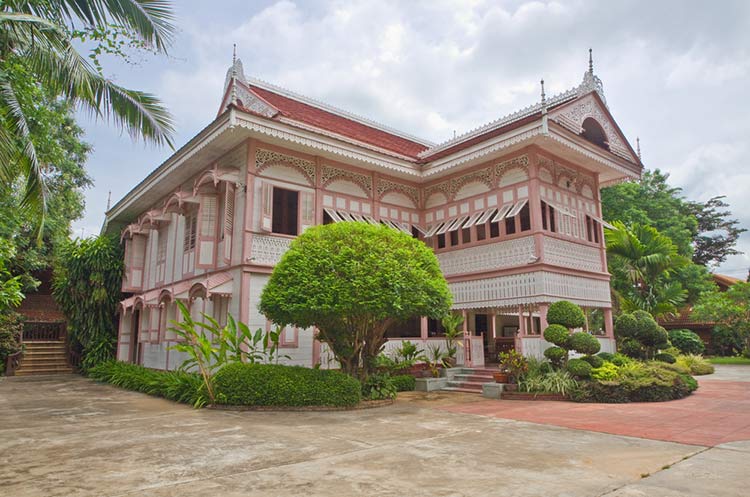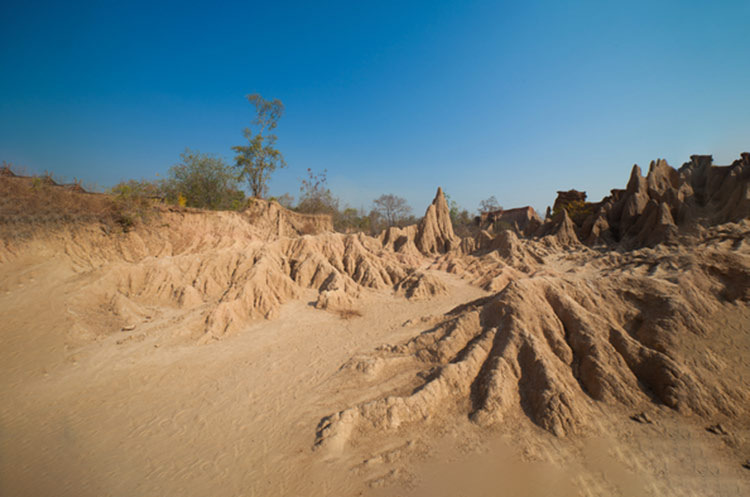
Phrae
Little visited province of history and forested mountains
Phrae is a little visited province rich in history and natural beauty in the North of Thailand, a place of forested mountains and valleys, national parks and traditional handicraft villages.
The province’s capital is Phrae town, a small town surrounded by mountains in the Yom river valley. The town which is surrounded by an ancient wall is one of the oldest in Thailand; it was founded in 1371.
Teak logging
During the late 19th, early 20th century Phrae was one of Thailand’s centers for the teak logging business. A number of large, impressive teak houses were built, some of which have been turned into museums.
Provincial seal
Phrae’s provincial seal shows a horse and the chedi of the Wat Phra That Cho Hae, one of Phrae’s most important temples. According to local belief two brothers once ruled Phrae and neighboring Nan. When they met on top of a hill to divide the land among them the brother from Nan rode a buffalo, while the brother from Phrae used a horse.
To do & see in Phrae
Phrae, a town with a long and rich history houses many historical sites, among them ancient Buddhist temples and 19th century wooden teak houses.
Buddhist temples
Phrae houses temples in several architectural styles including Lanna, Burmese and Thai Lü. Towards the end of the 19th century Phrae was one of the centers for the Thai teak logging business. The Burmese workers who were employed in the teak logging industry built their own Burmese style monasteries, such as the Wat Sa Bo Kaeo and Wat Chom Sawan.
The towns most famous temple is the Wat Phra That Cho Hae located on top of a hill South East of the old town. Its chedi from the 13th century enshrines relics from the Buddha.
The Wat Chom Sawan is a Burmese style temple built by Shan workers employed in the teak logging business early 20th century. Highlight is the large viharn with a multi tiered roof and very ornate interior with carvings in wood in bright red colors. Other structures include a large main chedi and several subsidiary chedis. The temple is found on Yantrakit Kosol road North of the old town.
The Wat Phra Non or “the temple of the reclining Buddha” consists of a large building serving as both viharn and ubosot with a multi tiered roof and a very ornate gable, a Ho Trai or scripture library raised on pillars, a gilded chedi and a chapel housing a large reclining Buddha image. The temple is located on Rop Muang road near the Yom river.
The Wat Luang is a large temple near the Yom river, its entrance guarded by lion statues. According to legend the temple was founded in the early 9th century. Its oldest structure is an octagonal chedi built in 1336, built over an older chedi. Protruding out of the chedi’s base are sculptures of elephants that seem to carry the structure on their backs, similar to the “elephant encircled chedis” of nearby Sukhothai Historical Park. Several niches contain standing images of the Buddha. The large combined viharn/ubosot built in the late 19th century contains the principal Buddha image of the temple, a large bronze image in the “Calling the Earth to witness” posture. The Ho Trai or scripture library is a large Shan Burmese style building with a multi tiered roof. On the grounds is a museum displaying Buddha images and Buddhist artifacts from several era.
Old teak houses
Over a century ago when Phrae was a center of the Thai teak logging business a number or large, impressive teak houses were built for the rulers of Phrae. Some of the teak houses that have survived, including Vongburi House, Pratubjai House and the Phrae Governor’s House have been turned into a museum.
Phrae handicrafts
Ban Thung Hong village is located a few kilometers North of Phrae town. The village is known for products as shirts, handbags and other products made from Mo Hom material, a cotton dyed in dark blue indigo, which have been made in the village for generations. The Kolom ancient fabric museum exhibits a collection of handmade fabrics of up to 2 centuries old. The museum is located off road 1023 in Long district of Phrae about 30 kilometers West of Phrae town.

Phae Muang Phi Forest Park
About 15 kilometers Northeast of Phrae town off Highway 101 is Phae Muang Phi Forest Park, a park with oddly shaped rock formations formed by erosion over the course of many centuries. The parks name loosely translates to “city of ghosts”. Sandstone formations in various shapes as mushrooms, chimneys, pillars and cliffs protrude from the surrounding land, some up to 15 meters high.
Getting to Phrae
Phrae is located about 550 kilometers North of Bangkok.
Air
The quickest way to get to Phrae is by air. The town’s airport is located a few kilometers East of the town. Nok Air offers daily flights from Bangkok’s Don Muang airport to Phrae which take 1 hour and 25 minutes. Fares start at around 2,500 Thai Baht one way.
Train
There is no train station in Phrae town. The nearest station is Den Chai, about 25 kilometers South of town. Several trains daily connect Chiang Mai with Den Chai. The trip takes 4 to 5 hours. Fares for 1st, 2nd and 3rd class are 194, 98 and 43 Baht respectively.
Trains from Bangkok’s Hua Lamphong station to Den Chai take between 7½ to a little over 10 hours depending on the type of service. Fares vary from about 200 Baht for 3rd class to 1,200 Baht for a first class sleeper.
From Den Chai to Phrae, take a bus or songthaew for around 30 Thai Baht.
Bus
Buses that depart from Bangkok’s Northern bus terminal Mo Chit to Phrae take 8 to 9 hours. Fares are between 300 and 700 Baht one way.
From Chiang Mai, buses from the Arcade bus station to Phrae take about 4 hours, fares are between 110 and 300 Baht.